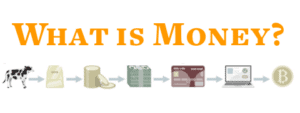The origins and history of money are often underappreciated – though it can tell us much about mistakes we may make with policy and money in the modern day. Most of us don’t think twice about where money came from or its forms in the past. We simply accept its existence, use it, and move on with our day. Much like a fish trying to understand water, this makes our understanding of money more difficult. Stepping back and looking at the history, however, gives us some useful perspective.
The credit (or debt) theory of money posits that money originated as a system for accounting debts, with monetary units in these systems representing debts – not inherent value. As a result, the mental difference we make between a credit/debt and a piece of money (like a nugget of gold) is false – they are one and the same.
This contrasts with the theory that types of money over time arose because they were the most frequently traded commodity in exchange. In this framework, credits and debts are different from monetary units because they can be created at will by transacting parties, whereas monetary units are made of scarce commodities like gold.
As for the origins of money, both likely happened in parallel. However, the implications that grow out of these theories are important to understand. First, let’s dive into the credit theory of money.
The Credit Theory of Money, Explained
The credit theory of money, sometimes referred to as the Debt Theory of Money, views money and credit as the same thing. While we usually think of money as some token that has value, and a credit (and corresponding debt) as a promise to repay, proponents of the credit theory say these are actually one and the same.
One supporter and writer on the topic was Mitchell Innes, who published the piece What Is Money in The Banking Law Journal in 1913. Innes argues that the traditional way of understanding money – as a solution for the problems of barter transactions – misses the point that money may have arisen as credit.
In his view, money and monetary units like coins are better understood as promises to pay or cancel a debt in the future. In this way, coins are not so much units of a specific value but representations in a system of accounting important to society as a mechanism for trust. There are historical examples of this, from clay tablets marking grain harvests in ancient Sumer to tally sticks in the Middle Ages.

The Role of Trust in Credit-based Money
A ‘monetary unit’ like a coin or bill is not dependent on the value of its contents when it is only viewed as a piece of credit. For example, a piece of paper signed by a friend that says “I owe you a sandwich” has no more value than a coin your friend created that says the same thing on it – both are representations of the sandwich debt. However, a commodity-based money like a gold coin is completely dependent on the amount and purity of the gold in that coin. When money is only viewed as credit, you give people the power to create money out of thin air. This can be a powerful tool, but it comes with dangers.
How do debt-based monetary systems overcome this problem? With trust. For a debt-based monetary system to work, participants must have great trust in each other that debts will be repaid. In a small community, this can be enforced through social pressures, and trust can be earned through daily interactions.
In larger communities, people must outsource trust-building to strong centralized institutions such as governments and banks. These institutions use the threat of punishment or imprisonment – backstopped by police forces and militaries – to enforce contracts (the payment of debts) and punish counterfeiters.
These counterfeiters are essentially trying to cheaply create more money which others will accept at face value – they want to create a stack of $100 bills for only $5, which is only possible in a credit-based monetary system. This is why all currency today has fancy watermarks – to make it harder to counterfeit.
In a debt-based monetary system, banks and governments are often the sole entities with the power to create money – everyone else is a counterfeiter who will be punished. This means people must trust that banks and governments will act in their best interest by not abusing their power to create money. Unfortunately, we’ve seen many governments and banks throughout history grossly abuse that power at the expense of their citizens by printing money to enrich themselves and their interests.
The notion that the government coin is the one and only dollar, and that all other forms of money are promises to pay that dollar, is no longer tenable in the face of the clear historical evidence to the contrary. A government dollar is a “promise to pay,” a “promise to redeem,” just as all other money is. All forms of money are identical in nature, namely a credit for the holder and a debt of the issuer.
Mitchell Innes – Source
The Commodity Theory of Money, Explained
To contrast with the credit theory of money, there is another, more common theory of money that says money arose out of commodities used in free trade. Over time, better forms of money naturally come about due to their suitable properties for trade – they are durable, easy to move, count, and divide. Most importantly, the best forms of money are scarce commodities.
Why is the best money scarce? Less production of new monetary units over time means a more durable value for each. If money were simply pieces of paper that anyone could print, that form of money would become worthless pretty fast. In this way, scarcity naturally fights counterfeiting. If a monetary unit is difficult to produce, it reduces the reward and incentive to counterfeit.
Think of it this way: If it cost $5 in raw materials to make $5,000, many people would rush to buy those raw materials and start literally ‘making money’. However, if it costs $4,990 in raw materials to make $5,000, far fewer people would go after that opportunity. The trouble of putting in the time and labor just wouldn’t be worth it for most people. It would be easier to just earn money through trade!
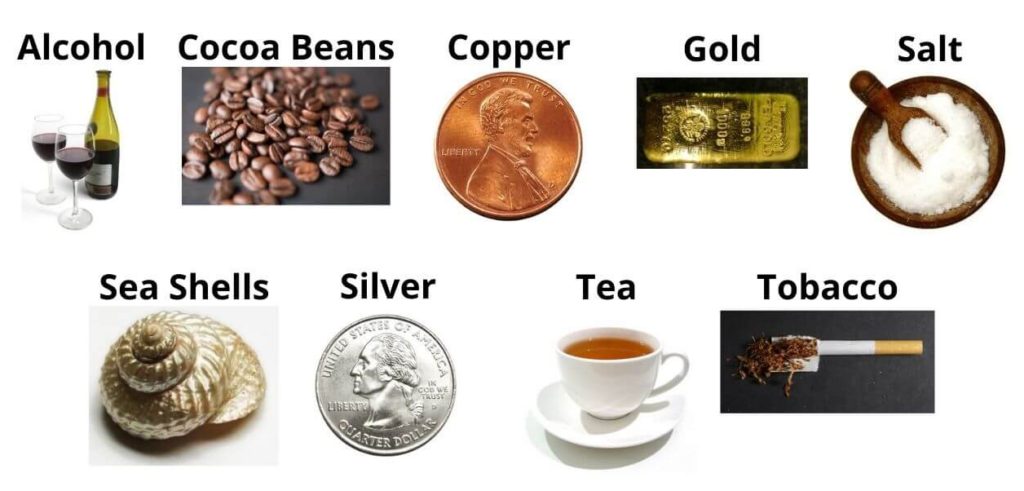
The commodity theory of money is explained here in further detail.
Today’s Money is Debt
Throughout history, the commodity story of the origins and function of money held far more support than the credit theory. However, our money today has more in common with the credit theory than any scarce commodity.
Today’s money is entirely based on debt since 1971. Prior to the ‘Nixon Shock’, the Bretton Woods world monetary system tied the value of all government paper currencies to gold, a scarce commodity with relatively stable value over millennia. However, in 1971, the link between currencies and gold was severed by President Nixon, and since then there is no scarce commodity backing our money – only debt from governments and banks.
When any government spends money, it is either spending tax money its citizens gave it, money it earned from selling services or collecting fines, or money created by its central bank in exchange for debt the government promises to repay. This last part makes a government’s ability to spend theoretically infinite – they can sell as much debt as they’d like to their central bank, and get newly printed currency in return. The only thing stopping them is a ‘debt ceiling’ written in law, which can be changed. All newly created money is debt.
When a bank lends to you, it is also creating debt-based money. You can spend that money as you would any other piece of currency, but you owe the bank that money back at a later date. You may go to an ATM and take out $100 of that loan and spend it out in the world. It’s still debt, because you still owe that money back to the bank.
Every piece of currency in your wallet and number in your bank account right now came from the government or a bank creating credits and debts.
Differences between Credit and Commodity Theories of Money
The main difference between these two monetary systems is the level of trust in people and institutions necessary for its function. Credit-based monetary systems suffer from a problem of scale – while they are flexible and don’t require finding scarce commodities, they break down when trading partners can’t be trusted to follow through on their debts.
The Scale Problem
With commodity-based money, you only need to trust natural laws and physics. For example, we have 5,000 years of history telling us that gold is very hard to find in the Earth’s crust, expensive to extract, and still impossible to fabricate from more plentiful raw materials. We do not need to trust any humans or institutions to do the right thing in order to know that gold is scarce.
Bitcoin is very similar – we only need to trust that ‘miners’ are self-interested and want to make money. Laws of mathematics and the physics of computer chips guarantee that creating bitcoins is difficult, making them provably scarce items. This is what people mean when they say that in order to trust Bitcoin, you only need to trust in math – the most pure science.
We can look at credit and commodity-based monies not as two systems, but as two ends of a spectrum.
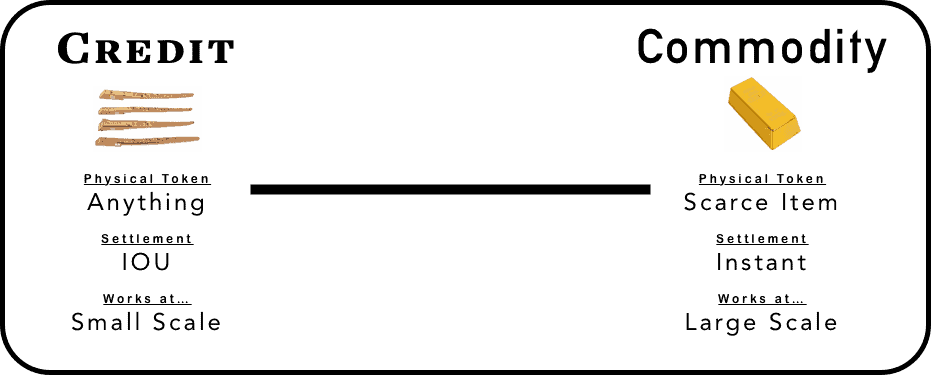
One works well at small scales and can use any physical items or ledgers to record ownership. The other works well at large scales because it requires no trust to operate. In order to bring credit-based money to larger scales, there must be institutions that mint a hard-to-counterfeit currency then use taxation and an associated threat of punishment to create demand for that currency. These institutions will keep this system afloat as long as they can convince people that their currency is scarce and trusted just like a commodity money – that it is ‘as good as gold’.
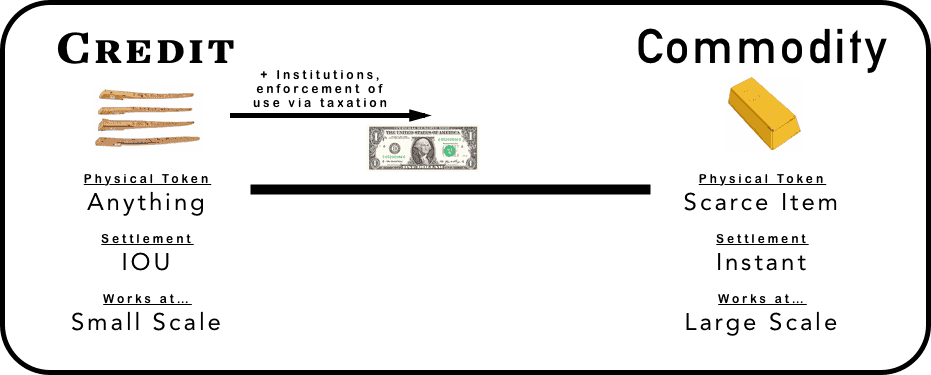
When they can convince a population to keep using their credit money as if it’s commodity money, these institutions gain the sole right to create money out of thin air. They can spend $5 to create $5,000, and nobody bats an eye.
The Scarcity Problem
Many debt-based monetary systems throughout history used clever mechanisms to avoid counterfeiting. The split tally of medieval times, for instance, involved notching a piece of wood several times and then splitting the piece down the middle so that only the two original pieces would fit back together. Each party in a transaction held one half of the piece. The number of notches represented the value, and the authenticity could be verified by matching the two pieces together.
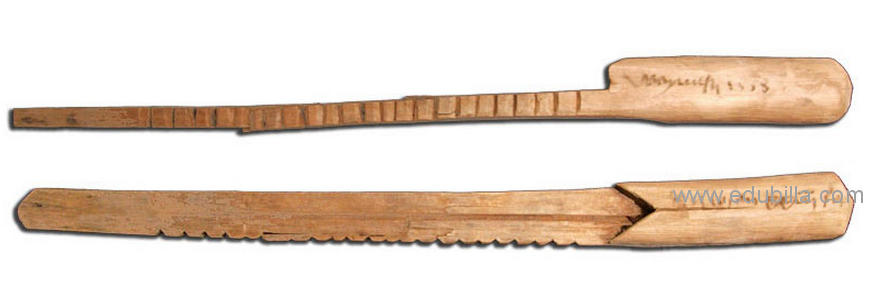
It is ironic to call this a debt-based monetary system, as many advocates of the credit theory of money do, because the split tally is really attempting to create commodity-based money in a crude way. Commodity-based monies are defined by the existence of a scarce, difficult to create or counterfeit commodity used in trade. A split tally tries to emulate this scarcity, but has the added cost of being difficult to verify – because you need the other half to prove the stick is genuine.
Commodity money earns its scarcity over time, the hard way. There is no law, decree, or institution which must choose the physical objects which represent ‘money’. Instead, time and use in trade reveal some items as good types of money due to their suitable properties.
The Printing Press Problem
A proponent of the credit theory of money, David Graeber, makes the point that throughout history, commodity monies like gold have been used as a tool by empires to legitimize their subjugation of other people. Take this example: Rome conquers a new area and then demands to be paid tribute for damages in a scarce commodity like gold. Since gold is very hard to find but Rome has a lot of it, the conquered peoples will have to work for the Romans at any price in order to pay this tribute.
However, Graeber actually makes a point against the credit theory in this example, not the commodity theory. The important elements of the above are the violence imposed by the Romans and the difference in access to gold between Romans and conquered people. If the conquered people could rise up, this would all be avoided. It could also be avoided if the conquered people had access to gold with the same ease as the Romans – they could repay without having to work at any price for their conquerors.
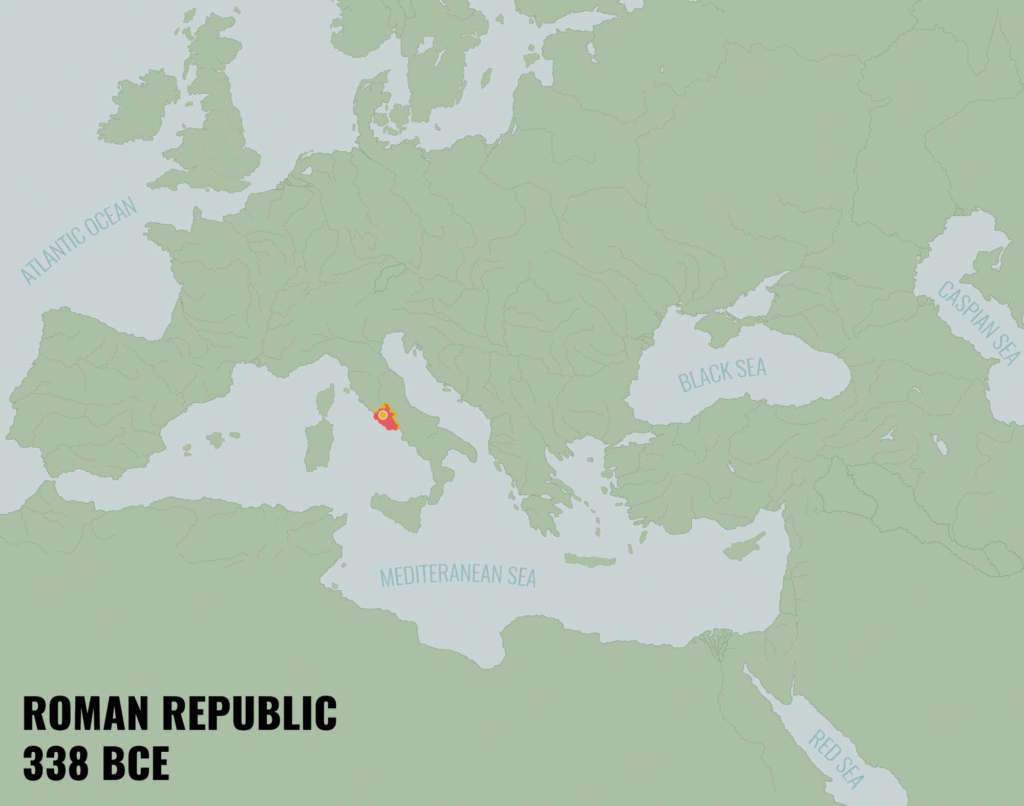
The violence point will always be true, outside of any monetary system. However, the difference in access to the monetary unit can be created in any monetary system, whether credit or commodity-based. The Romans could have instead asked for tribute to be paid in parchment with the signature of any Roman citizen on it. This is very cheap for a Roman to produce, but impossible for the conquered people to create on their own.
I call this the ‘printing press’ problem: whoever has the power to produce the money can subjugate everyone else. The bigger the difference between the cost to create the money and the purchasing power of that money, the more power to subjugate. Commodity-based monies, like gold coins, often trade for around the same value as their raw materials – so there is often little profit and power to be gained by creating more of them. However, credit-based monies are valued by the promises written on them, not the value of their raw materials. This creates a big printing press problem.
In today’s world, the printing press problem runs rampant. Governments, especially the United States, use their ability to print money to subjugate other nations and their own citizens. Taxes are the main vehicle for this – they are the modern parallel of a tribute payment to Rome. While we must work to earn the money we use to pay taxes, governments can print that same money for themselves with near-zero effort or cost. Governments get the fruits of our labor, we get inflation and increasingly worse services.

Implications of the Credit Theory of Money
The credit theory of money adds a fresh perspective on the idea of money, which is always welcome. However, it has more to do with banking than with money itself, and attempting to conflate the two brings confusion. Despite this, I’ve included David Graeber’s book in my recommended resources on money, because I do think it’s an interesting way to look at money that probably played a role in the origins of money today.
A growing movement called Modern Monetary Theory is attempting to bring the credit theory of money to light and drive politicians to make full use of it – this topic deserves a post of its own in the near future.
If you like my work, please share it with your friends and family. My goal is to provide everyone a window into economics and how it affects their lives.
Subscribe to email updates when new posts are published.
All content on WhatIsMoney.info is published in accordance with our Editorial Policy.
